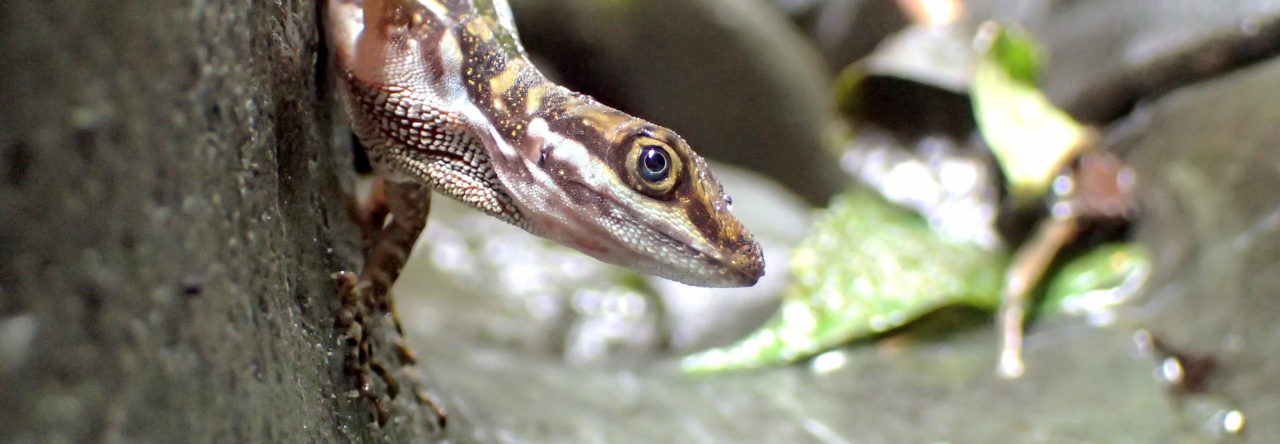Anolis krugi, a grass-bush anole from Puerto Rico. Photo from the Reptile Database.
Anolis pulchellus. Photo by Emelia Failing
Although closely-related, the Puerto Rican grass-bush anoles Anolis pulchellus and A. krugi are easy to tell apart based on body shape and color and, particularly, dewlap color. Moreover, they are ecologically different, A. pulchellus preferring hotter microhabitats. Their population genetics, however, are not so straightforward. In a paper now available online at The Journal of Evolutionary Biology, Teresa Jezkova, Manuel Leal and Javier Rodríguez-Robles show that there’s some interspecific hanky-panky going on, or at least there was in the past.
The evidence comes from examination of their mitochondrial DNA. To make a long story short, A. pulchellus in western Puerto Rico seem to have nothing but A. krugi mtDNA. Moreover, there is variation within A. krugi in mtDNA, and this variability is matched geographically by A. pulchellus. That is, western A. pulchellus have the appropriate mtDNA for the A. krugi at their particular locality. The authors suggest that this mitochondrial introgression has occurred many times independently. To make things more complicated, some western A. pulchellus that occur in areas in which A. krugi does not occur—and probably hasn’t for a long time—still have the krugi mtDNA.
 And, in case you’re wondering, a pulchellus looks like a pulchellus regardless of its mtDNA. Moreover, one of two nuclear genes examined fell out nicely, with one clade containing A. pulchellus and the other containing A. krugi. Go figure! I’ve pasted the abstract below which gives more details and the authors’ hypothesis of how this came to be.
And, in case you’re wondering, a pulchellus looks like a pulchellus regardless of its mtDNA. Moreover, one of two nuclear genes examined fell out nicely, with one clade containing A. pulchellus and the other containing A. krugi. Go figure! I’ve pasted the abstract below which gives more details and the authors’ hypothesis of how this came to be.
Abstract
Hybridization and gene introgression can occur frequently between closely related taxa, but appear to be rare phenomena among members of the species-rich West Indian radiation of Anolis lizards. We investigated the pattern and possible mechanism of introgression between two sister species from Puerto Rico, Anolis pulchellus and Anolis krugi, using mitochondrial (ND2) and nuclear (DNAH3, NKTR) DNA sequences. Our findings demonstrated extensive introgression of A. krugi mtDNA (k-mtDNA) into the genome of A. pulchellus in western Puerto Rico, to the extent that k-mtDNA has mostly or completely replaced the native mtDNA of A. pulchellus on this part of the island. We proposed two not mutually exclusive scenarios to account for the interspecific matings between A. pulchellus and A. krugi. We inferred that hybridization events occurred independently in several populations, and determined that k-mtDNA haplotypes harboured in individuals of A. pulchellus can be assigned to four of the five major mtDNA clades of A. krugi. Further, the spatial distribution of k-mtDNA clades in the two species is largely congruent. Based on this evidence, we concluded that natural selection was the probable driving mechanism for the extensive k-mtDNA introgression into A. pulchellus. Our two nuclear data sets yielded different results. DNAH3 showed reciprocal monophyly of A. pulchellus and A. krugi, indicating no effect of hybridization on this marker. In contrast, the two species shared nine NKTR alleles, probably due to incomplete lineage sorting. Our study system will provide an excellent opportunity to experimentally assess the behavioural and ecological mechanisms that can lead to hybridization in closely related taxa.


 In the next two days, everybody who’s anybody in evolutionary biology will be winging his or her way to beautiful Snowbird, Utah for the 2013 Evolution meetings. And, as always, anole lizards will be major players.
In the next two days, everybody who’s anybody in evolutionary biology will be winging his or her way to beautiful Snowbird, Utah for the 2013 Evolution meetings. And, as always, anole lizards will be major players.

 A
A 









 A new journal focused on the natural history of Caribbean fauna and flora has just been announced. As the sample cover to the left illustrates, it might be a great place to publish observations on our favorite critters. The journal has a distinguished board of editors and the webpage states:
A new journal focused on the natural history of Caribbean fauna and flora has just been announced. As the sample cover to the left illustrates, it might be a great place to publish observations on our favorite critters. The journal has a distinguished board of editors and the webpage states: